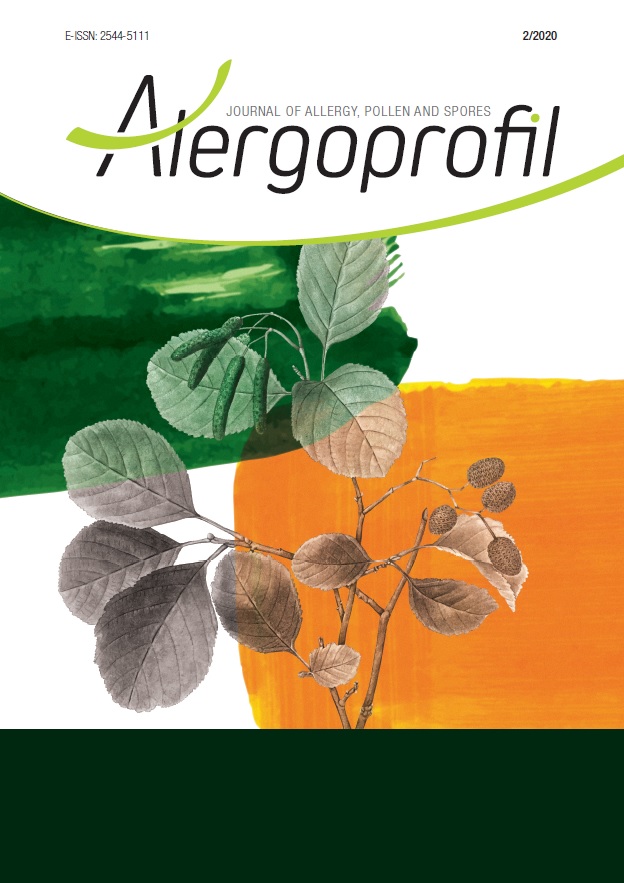Variability in the Betula pollen concentrations in the atmosphere of six urban areas in Slovakia in 2018 Artykuł oryginalny
##plugins.themes.bootstrap3.article.main##
Abstrakt
Betula pollen is one of the most important aeroallergens during the spring months in the central European countries. In 2018, pollen monitoring was conducted in six urban areas (Bratislava, Banská Bystrica, Košice, Nitra, Trnava, and Žilina) in Slovakia. Investigations were carried out using a volumetric Hirst-type pollen trap (Burkard). Betula pollen season timing was determined by the 90% method when the start and end of the season were defined as the date when 5% and 95%, respectively of the total pollen sum was reached. The pollen season start date was recorded earliest in Bratislava (April 8th) and latest in Banská Bystrica (April 12th). The highest both seasonal total pollen concentration (7,390 P/m3) and birch pollen allergen risk were found in Banská Bystrica. The shortest pollen season was recorded in Žilina (13 days) and the longest in Košice (25 days). Peak daily pollen concentrations ranged between 1,567 P/m3 in Žilina and 202 P/m3 in Košice.
Pobrania
##plugins.themes.bootstrap3.article.details##

Utwór dostępny jest na licencji Creative Commons Uznanie autorstwa – Użycie niekomercyjne – Bez utworów zależnych 4.0 Międzynarodowe.
Copyright: © Medical Education sp. z o.o. This is an Open Access article distributed under the terms of the Attribution-NonCommercial 4.0 International (CC BY-NC 4.0). License (https://creativecommons.org/licenses/by-nc/4.0/), allowing third parties to copy and redistribute the material in any medium or format and to remix, transform, and build upon the material, provided the original work is properly cited and states its license.
Address reprint requests to: Medical Education, Marcin Kuźma (marcin.kuzma@mededu.pl)
Bibliografia
2. Beggs PJ. Impacts of climate change on aeroallergens: past and future. Clin Exp Allergy. 2004; 34: 1507-13.
3. Hrubiško M. Polinóza – aktuálny problém aj v XXI. storočí. Časť III: poradie a skrížené reaktivity alergénnych druhov stromov, tráv a bylín podľa ich klinického významu/Polinose – actual problem also in XXI. Century. Part III: sequence and cross reactivity of allergen tree, grass and plant species by their clinical significance. Klinická Imunológia a Alergológia. 1998; 2: 9-17.
4. Hynynen J, Niemistö P, Viherä-Aarnio A et al. Silviculture of birch (Bitola pendula Roth and Bitola pubescens Ehrh. In Northern Europe. Forestry. 2010; 83(1): 103-19.
5. Skjøth CA, Sommer J, Brandt J et al. Copenhagen – a significant source of birch (Bitola) pollen? Int J Biometeorol. 2008; 52(6): 453-62.
6. Sofiev M, Siljamo P, Ranta H et al. Towards numerical forecasting of long-range air transport of birch pollen: Theoretical considerations and a feasibility study. Int J Biometeorol. 2006; 50: 392-402.
7. Piotrowska-Weryszko K, Weryszko-Chmielewska E. Plant pollen content in the air of Lublin (central-eastern Poland) and risk of pollen allergy. Ann Agric Environ Med. 2014; 21(4): 693-96.
8. Ščevková J, Dušička J, CHrenová J et al. Annual pollen spectrum variations in the air of Bratislava (Slovakia): years 2002-2009. Aerobiologia. 2010; 26: 277-87.
9. Grewling Ł, Jackowiak B, Nowak M et al. Variations and trends of birch pollen seasons during 15 years (1996–2010) in relation to weather conditions in Poznań (western Poland). Grana. 2012; 51: 280-92.
10. British Aerobiology Federation. Airborne pollen and spores. A guide to trapping and counting. National Pollen and Hay fever Bureau, Rotherham 1995.
11. Nilsson S, Persson S. Tree pollen spectra in the Stockholm region (Sweden), 1973–1980. Grana. 1981; 20: 179-82.
12. Gehrig R, Peeters AG. Pollen distribution at elevations above 1000 m in Switzerland. Aerobiologia. 2000; 16(1): 69-74.
13. Galán C, Garca-Mozo H, Vázquez L et al. Heat requirement for the onset of the Olea europaea L. pollen season in several sites in Andalusia and the effect of the expected future climate change. Int J Biometeorol. 2005; 49(3): 184-8.
14. Ščevková J, Dušička J, Mičieta K et al. The effects of recent changes in air temperature on trends in airborne Alternaria, Epicoccum and Stemphylium spore seasons in Bratislava (Slovakia). Aerobiologia. 2016; 32(1): 69-81.

